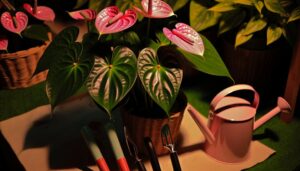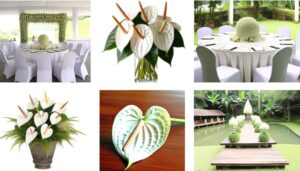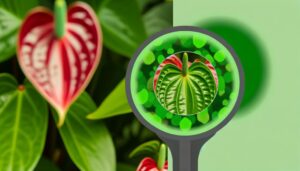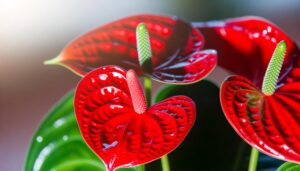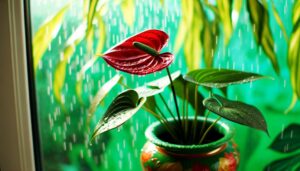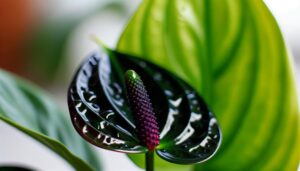What Makes Anthurium Dutch Red Special?
You'll be amazed by Anthurium Dutch Red's vibrant red blooms, rich in anthocyanin pigments that deter herbivores and protect against UV damage. Its heart-shaped flowers maximize light capture and guide pollinators for efficient reproduction.
With specialized epidermal cells and adaptive physiological traits, Anthurium Dutch Red thrives in varying light conditions and regulates moisture with minimal watering. Its lignified cell walls provide resilience, while its air-purifying qualities enhance indoor air quality by absorbing formaldehyde, ammonia, and xylene.
This botanical marvel also serves as a versatile decor element, adding elegance to various interior styles. Explore further to reveal this plant's full potential.
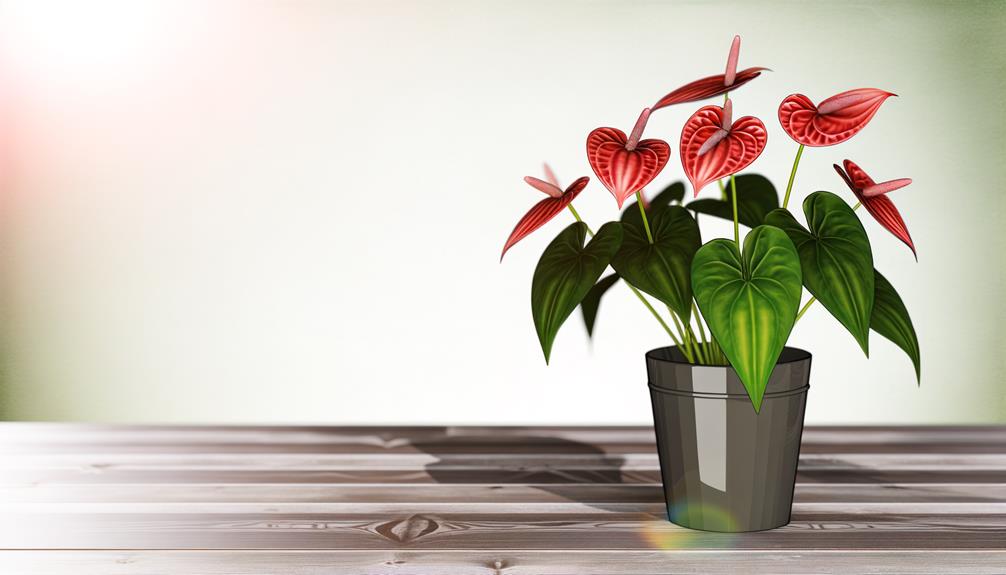
Key Takeaways
- Vibrant red blooms with high anthocyanin pigments offer UV protection and herbivore deterrence.
- Unique heart-shaped flowers enhance photosynthesis and attract pollinators efficiently.
- Adaptable to various light conditions and low maintenance with minimal watering needs.
- Excellent air-purifying capabilities, absorbing formaldehyde, ammonia, and xylene.
- Versatile decor element, enhancing styles like Modern Minimalism and Bohemian Chic.
Vibrant Red Blooms
The vibrant red blooms of Anthurium Dutch Red, characterized by their striking spathes and protruding spadices, are a result of high concentrations of anthocyanin pigments. You'll find these pigments localized within the vacuoles of the plant's epidermal cells, giving the blooms their intense color.
The anthocyanins not only provide the red hue but also protect the plant by absorbing UV light and deterring herbivores. When you look closely, you'll notice the spathes exhibit a glossy texture due to specialized epidermal cells that reduce transpiration.
Additionally, the spadices serve as the reproductive structures, housing numerous tiny flowers. Their bright red coloration is a signal to pollinators, ensuring the plant's reproductive success.
Essentially, these blooms are a marvel of botanical engineering.
Unique Heart-Shaped Flowers
Beyond their vibrant red hues, Anthurium Dutch Red also captivates with its unique heart-shaped flowers, a morphological adaptation that not only enhances aesthetic appeal but also maximizes surface area for photosynthesis and pollinator attraction.
These spathes, technically modified leaves, cradle the spadix, where true flowers reside. The heart shape facilitates efficient light capture, increasing photosynthetic efficiency. Additionally, this form enhances visibility to pollinators like bees and butterflies, optimizing reproductive success.
The curvature of the spathe directs pollinators towards the spadix, ensuring effective pollen transfer. Essentially, the heart-shaped spathes serve dual functions—augmenting photosynthetic capacity and acting as visual lures, thereby ensuring the plant's survival and propagation.
This clever design embodies the intricate interplay between form and function in plant morphology.
Resilient Nature
Anthurium Dutch Red consistently demonstrates remarkable resilience, thriving in diverse environmental conditions due to its robust physiological adaptations. You'll find its high tolerance to varying light levels and humidity impressive. The plant's lignified cell walls and efficient water-use mechanisms enable it to withstand both drought and occasional waterlogging. Root system adaptability further enhances its resilience.
| Environmental Factor | Adaptation Mechanism |
|---|---|
| Light Levels | Chloroplast density adjustment |
| Humidity | Stomatal regulation |
| Water Availability | Osmotic balance control |
| Soil Conditions | Root plasticity |
These adaptations contribute to its longevity and vigor, ensuring your Anthurium Dutch Red remains lush and vibrant under diverse conditions. With these physiological strengths, it's no wonder you'd find this plant remarkably enduring.
Low Maintenance Requirements
You'll appreciate Anthurium Dutch Red's minimal watering needs, as it thrives with infrequent hydration, reducing the risks of root rot.
Its simple light preferences, favoring bright indirect sunlight, make placement straightforward without the need for specialized grow lights.
Additionally, it adapts to easy soil conditions, performing well in a well-draining potting mix, which simplifies maintenance to a great extent.
Minimal Watering Needs
Due to its epiphytic nature, the Anthurium Dutch Red requires minimal watering, thriving on the moisture absorbed from the air and infrequent, deep watering sessions. This makes it ideal for those who seek low-maintenance plants. You'll need to water it only when the upper inch of soil feels dry. Overwatering can lead to root rot, a common issue with epiphytes. By mimicking its natural habitat, you ensure peak growth with minimal effort.
Here's a quick reference guide:
| Watering Frequency | Soil Moisture Level | Potential Issues |
|---|---|---|
| Every two weeks | Top inch dry | Root rot if overwatered |
| Humidity | Moderate to high | Dry leaf tips if too low |
| Deep Watering | Infrequent | Stagnant water if excess |
Simple Light Preferences
In environments with indirect, bright light, the Anthurium Dutch Red exhibits ideal growth while tolerating lower light conditions, making it perfect for low-maintenance care.
You'll find that this adaptability stems from its efficient photosynthetic machinery, which operates effectively even under suboptimal light. The plant's chlorophyll concentration allows it to maximize light absorption, ensuring continuous growth despite variable lighting.
Positioning your Anthurium near a north or east-facing window will offer the right balance of luminosity. Avoid direct sunlight, as it can scorch the foliage. Low light tolerance reduces the need for frequent repositioning, making your care routine simpler.
This resilience to light variations makes Anthurium Dutch Red an excellent choice for those seeking both beauty and ease in plant care.
Easy Soil Conditions
Anthurium Dutch Red flourishes in well-draining soil rich in organic matter, promoting prime root health and nutrient uptake. You'll want to use a mixture containing peat moss, pine bark, and perlite. This combination offers excellent aeration and moisture retention, reducing the risk of root rot while maintaining adequate hydration. Incorporating charcoal can help with toxin absorption, further enhancing soil conditions.
To maintain low maintenance, make sure the pH level stays between 5.5 and 6.5, fostering ideal nutrient availability. Regularly check soil moisture, letting the top inch dry out between waterings. This prevents overwatering, a common pitfall.
Year-Round Flowering
You can sustain your Anthurium Dutch Red blooms year-round by carefully controlling light, temperature, and humidity levels. Maintaining optimal conditions will promote continuous flowering and vibrant spathes. Provide bright, indirect light to replicate their native tropical habitat.
Keep temperatures between 70-85°F (21-29°C) and humidity levels at least 60%.
To achieve year-round flowering, consider these key factors:
- Light: Position your Anthurium in a spot with filtered sunlight.
- Temperature: Maintain consistent warmth in the surroundings.
- Humidity: Utilize a humidifier or pebble tray to uphold high humidity.
- Watering: Water when the top inch of soil feels dry, ensuring adequate drainage.
- Fertilization: Apply a balanced, water-soluble fertilizer monthly during the growing season.
Paying attention to these factors guarantees flourishing, year-round blooms.
Ideal Indoor Plant
With its striking crimson spathes and sturdy foliage, the Anthurium Dutch Red stands out as an ideal indoor plant due to its adaptability and minimal care needs.
You'll appreciate its ability to thrive in a variety of light conditions, from indirect sunlight to dim light. Its robust leaves show high transpiration efficiency, reducing water loss and maintaining turgor pressure.
You won't need to fret about frequent watering; this species prefers its soil to dry slightly between waterings. Additionally, Anthurium Dutch Red's tolerance to typical household humidity levels underscores its suitability for indoor environments.
Air-Purifying Qualities
You'll find that Anthurium Dutch Red excels at removing harmful toxins such as formaldehyde and ammonia from the air. Its unique physiology not only improves indoor air quality but also acts as a natural humidity regulator, maintaining ideal moisture levels.
This plant's ability to enhance your living environment is rooted in its efficient air-purifying capabilities.
Removes Harmful Toxins
Several studies have demonstrated that Anthurium Dutch Red effectively removes harmful toxins such as formaldehyde, ammonia, and xylene from indoor air. When you introduce this plant into your home, you're not just adding beauty but also engaging in a natural detoxification process.
Anthurium Dutch Red's large, vibrant leaves are excellent at absorbing and breaking down these volatile organic compounds (VOCs).
- Formaldehyde: Commonly found in household products and building materials.
- Ammonia: Often present in cleaning supplies.
- Xylene: Emitted from paints, varnishes, and adhesives.
- Phytoremediation: The plant's ability to absorb, sequester, and degrade pollutants.
- Stomatal Conductance: Enhances the plant's air-purifying efficiency.
Improves Indoor Air Quality
Anthurium Dutch Red greatly enhances indoor air quality by efficiently filtering out pollutants and increasing oxygen levels. Its foliage absorbs volatile organic compounds (VOCs) such as formaldehyde, ammonia, and xylene, converting them into harmless substances. This plant employs phytoremediation, leveraging natural processes to detoxify the air.
| Pollutant | Absorption Efficiency | Harmful Effects |
|---|---|---|
| Formaldehyde | High | Respiratory issues, skin irritation |
| Ammonia | Moderate | Eye irritation, coughing |
| Xylene | High | Headaches, dizziness |
Anthurium Dutch Red's stomatal conductance optimizes gas exchange, ensuring a continuous supply of oxygen. By incorporating this plant into your living space, you're not just adding beauty but also fostering a healthier, more breathable environment. This symbiotic relationship benefits both you and the plant, making it a precious addition to any home.
Natural Humidity Regulator
By leveraging its natural transpiration process, the Anthurium Dutch Red acts as an efficient humidity regulator, maintaining ideal moisture levels in indoor environments. This plant's ability to release water vapor from its leaves helps stabilize the air's moisture content.
You'll appreciate how this contributes to a healthier living space by reducing respiratory irritants and static electricity. The Anthurium Dutch Red doesn't just add aesthetic value; it actively improves your home's microclimate.
- Enhances indoor air quality by maintaining ideal humidity levels
- Reduces respiratory issues by minimizing airborne pollutants
- Lowers static electricity, making your environment more cozy
- Promotes better skin hydration by preventing overly arid air
- Supports other houseplants by creating a more harmonious ecosystem
This plant's symbiotic relationship with your environment makes it indispensable.
Versatile Decor Element
You'll find the Anthurium Dutch Red to be an adaptable and scientifically fascinating addition to your decor, as its striking red spathes and glossy leaves can enhance various interior design styles while also improving air quality. Its vibrant pigmentation results from anthocyanin compounds, which not only create visual appeal but also contribute to its resilience. The plant's ability to undergo photosynthesis and respiration efficiently aids in mitigating indoor pollutants, such as formaldehyde and xylene.
| Design Style | Anthurium Dutch Red Feature |
|---|---|
| Modern Minimalism | Clean lines, bold color |
| Bohemian Chic | Exotic, vibrant aesthetics |
| Classic Elegance | Timeless, sophisticated charm |
Easy Propagation Techniques
To propagate the Anthurium Dutch Red effectively, start by selecting a healthy parent plant with robust roots and vibrant foliage. Gently remove the plant from its pot, ensuring minimal root disturbance. Identify a section with at least one aerial root and a few leaves. Using a sterilized knife, carefully cut this section from the parent plant.
Prepare a well-draining potting mix: Combine orchid bark, perlite, and peat moss.
Plant the cutting: Place it in the potting mix, making sure the roots are well-covered.
Maintain humidity: Use a plastic bag or humidity dome to cover the cutting.
Water sparingly: Keep the soil moist but not waterlogged.
Provide indirect light: Place in a bright, indirect light location.
Conclusion
To sum up, you'll find that the Anthurium Dutch Red is more than just a beautiful plant—it's a resilient, low-maintenance marvel. Its vibrant, heart-shaped blooms can brighten any space year-round, while its air-purifying qualities improve your indoor environment.
As the saying goes, 'A stitch in time saves nine,' and investing in this versatile, easy-to-propagate plant will pay dividends in both aesthetic and health benefits.
Embrace the science of anthuriums and transform your living space today.

